
Types of the 2¢ Washington of the 1922 - 1934 Series
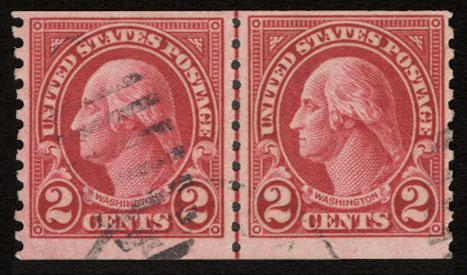
Three Areas that Distinguish Types I and II of the 2c Design of the 1922-1934 Series
The stamps at the left are a joint-line coil pair of both types of the 2¢ stamp. The stamp on the left is the type I Scott 599 and the stamp on the right is the type II stamp Scott 599A. A strongly printed type I stamp may seem to have tell-tale signs of these added hairlines, but never approaching the distinction of the example here. See the diagram below for a clearer example of the two distinct lines. A word of advice, do not fret over this stamp. One thing is certain, you do not need to study this stamp closely under heavy magnification to determine whether it is a type I or a type II. Once you know what to look for this stamp is actually very easy to identify. Study the diagrams below and you should have no problem distinguishing the type II.
Only the rotary press printings of the 2¢ Washington of the 1922-1934 Series Design may have the type II (i.e. "A") design. If your stamp is flat plate and appears to be type II, it is not genuine.
The type I, perf 10, rotary coil stamp, Scott 599, was first printed in 1923. The type II, perf 10, rotary coil stamp, Scott 599A, was first printed in 1929. If the stamp has a cancel or is on a cover before 1929, it can not be a type II, 599A. The type I, rotary press, perf 10½ x 11 stamp, Scott 634, was first printed in 1926. The type II, rotary press, perf 10½ x 11 stamp, Scott 634A, was first printed in 1928. If the stamp has a cancel before or is on a cover before 1928, it can not be a type II, 634A.
Although, the most distinguishing characteristic that separates the type I and type II stamps is the heavier lines in the hair, another key in identifying the type II stamps is to examine the acanthus scroll at the left. Note the heavy line separating the scroll from the outer line of the frame of the Washington vignette. This is perhaps the easier method of identification; a quick glance at the hairline, but study the line above the acanthus in detail. In the case of a cancellation covering the identification areas, or if the ink is light, or if you simply have a faded copy, you will need to examine all three areas.
Side-by-Side Comparison of Type I and Type II The 2¢ Washington of the 1922-34 Design
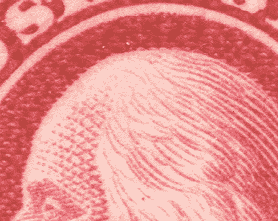
Type I
Lines in Hair
Scott 599 and 634 - This is the typical detail in the hair for this issue. On particularly well inked copies of this stamp it may be heavier with slightly more detail, but clearly no where near the striking detail as in the three added lines in the Type II stamp at right.
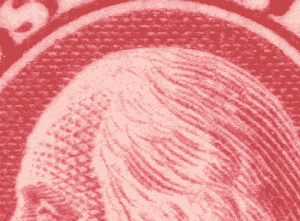
Type II
Lines in Hair
Scott 599A and 634A - The three added lines in the forehead of the Type II stamp are readily apparent. Do not spend hours agonizing over a Type I stamp with a magnifying glass. If your stamp looks like this one, immediately perform the next step, examine the line above the Acanthus scroll.
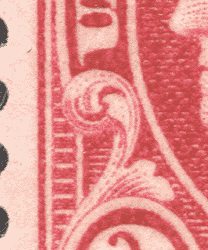
Type I
Line Above Acanthus
Scott 599 and 634 - The line separating the scroll from the outer line of the frame of the Washington vignette is light. The detail in the Acanthus scroll itself is not as sharp as in the Type II stamp.
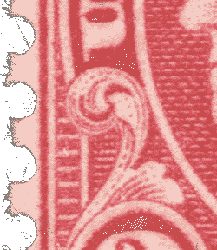
Type II
Line Above Acanthus
Scott 599A and 634A - The line separating the scroll from the outer line of the frame of the Washington vignette is strong and much thicker than in the Type I stamp. The detail in the Acanthus scroll itself is sharper than in the Type I stamp.
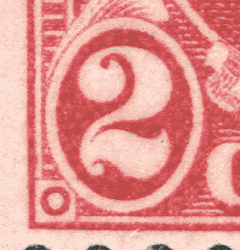
Type I
Detail in Corner Circles
Scott 599 and 634 - The rectangle around the corner circles is heavier and less well-defined than in the Type II stamp. The circles are slightly heavier and less well-defined than in the Type II stamp. The lower left corner was used for illustration purposes.
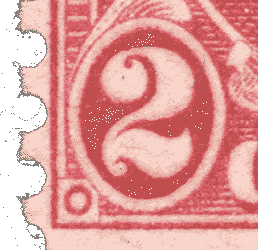
Type II
Detail in Corner Circles
Scott 599A and 634A - The rectangle around the corner circles is lighter and more well-defined than in the Type I stamp. The circles are slightly lighter, thinner and more well-defined than in the Type I stamp.





